Click on images to enlarge

habit (Photo: Sheldon Navie)

habit in flower (Photo: Sheldon Navie)
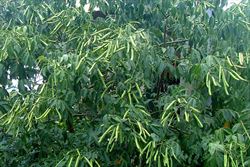
habit in fruit (Photo: Sheldon Navie)
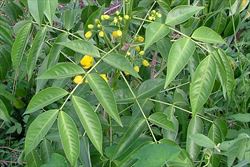
once-compound leaves with several pairs of leaflets (Photo: Sheldon Navie)

stem and leaf showing small conical glands between each pair of leaflets (Photo: Sheldon Navie)

close-up of leaflets with pointed tips (Photo: Sheldon Navie)

flower cluster (Photo: Sheldon Navie)
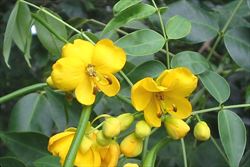
close-up of flowers (Photo: Sheldon Navie)
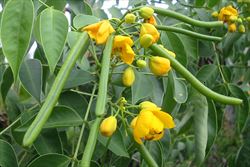
flower buds and young fruit (Photo: Sheldon Navie)
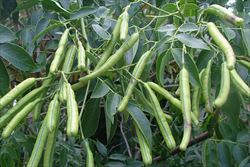
immature fruit (Photo: Sheldon Navie)
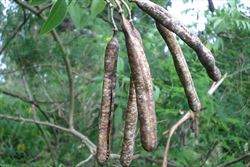
mature fruit (Photo: Sheldon Navie)
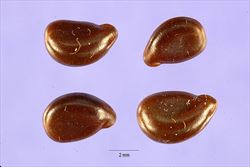
close-up of seeds (Photo: Tracey Slotta at USDA PLANTS Database)
Scientific Name
Senna septemtrionalis (Viv.) H.S. Irwin & Barneby
Synonyms
Cassia corymbosa Lam. (misapplied)Cassia floribunda Cav. (misapplied)Cassia laevigata Willd.Cassia septemtrionalis Viv.Senna x floribunda (Cav.) H.S. Irwin & Barneby (misapplied)
Family
Caesalpiniaceae (Queensland, the ACT, Victoria, Tasmania, Western Australia and the Northern Territory)Fabaceae: sub-family Caesalpinioideae (New South Wales)Leguminosae (South Australia)
Common Names
arsenic bush, Brazilian buttercup, buttercup bush, Dooleyweed, laburnum, senna, smooth leaved senna, smooth senna, yellow shower
Origin
Native to Mexico and Central America (i.e. northern Costa Rica, Guatemala, Honduras and Nicaragua).
Cultivation
This species has escaped cultivation as a garden ornamental, though it is generally rarely if ever deliberately cultivated anymore.
Naturalised Distribution
Widely naturalised in eastern Australia (i.e. in eastern Queensland and the coastal districts of New South Wales). Also naturalised on Lord Howe Island and Norfolk Island, and possibly naturalised in Victoria.
Habitat
A weed of moist forests, rainforests and riparian vegetation in tropical, sub-tropical and warmer temperate regions. It is also occasionally found in open woodlands, along roadsides, and in disturbed sites and waste areas.
Habit
Usually a shrub growing 1-3 m tall, but occasionally a small tree reaching up to 5 m or more in height.
Distinguishing Features
- a shrub or small tree growing 1-5 m tall.
- its once-compound leaves (6-10.5 cm long) have 3-5 pairs of leaflets with pointed tips.
- these leaves have a small cone-shaped structure between the lowest three or four pairs of leaflets.
- its yellow flowers have five petals and six or seven fully-formed stamens, two of which are larger than the others.
- its cylindrical pods (5-10 cm long and 7-12 mm wide) are usually borne in an upright position on stiff stalks.
Stems and Leaves
The once-compound (i.e. pinnate) leaves are hairless (i.e. glabrous) and alternately arranged along the stems. These leaves (6-10.5 cm long) are borne on stalks (i.e. petioles) 15-35 mm long and have 3-5 pairs of leaflets. There is a small cone-shaped structure (i.e. erect conical gland) between the lowest three or four pairs of leaflets. The leaflets (3.5-9 cm long and 15-35 mm wide) are elongated to egg-shaped in outline (i.e. lanceolate to narrowly ovate) with entire margins and pointed tips (i.e. acuminate apices). They have glossy green upper surfaces and paler green undersides.
Flowers and Fruit
The flower clusters (2.5-8 cm long) are borne on stalks (i.e. peduncles) 3-4 cm long and usually contain 4-10 flowers. Individual flowers are borne on stalks (i.e. pedicels) 10-13 mm long that elongate to 25 mm in fruit. Each flower has five yellowish-green, yellowish-brown, or pale yellow sepals (4-10 mm long) and five bright yellow or golden yellow petals (12-16 mm long). The uppermost petal (i.e. standard) is slightly larger than the others and has a notched tip. The flowers also have six or seven stamens, two of which are larger than the others, and three partially-formed stamens (i.e. staminodes). Flowering occurs mainly during spring and autumn.
The cylindrical pods (5-10 cm long and 7-12 mm wide) turn from green to brown or straw-coloured as they mature. They are usually borne in an upright position on stiff stalks. The olive or brown seeds (3.5-5 mm long) are somewhat flattened with smooth or minutely pitted surfaces.
Reproduction and Dispersal
This plant reproduces mainly by seed, which are dispersed by water or in mud sticking to animals, humans, machinery and vehicles. They may also be spread as a contaminant of agricultural produce.
Environmental Impact
Smooth senna (Senna septemtrionalis) is regarded as an environmental weed in Queensland and New South Wales.
Legislation
Not declared or considered noxious by any state government authorities.
Similar Species
Smooth senna (Senna septemtrionalis) is very similar to coffee senna (Senna occidentalis), sicklepod (Senna obtusifolia), Java bean (Senna tora), hairy senna (Senna hirsuta), Easter cassia (Senna pendula var. glabrata) and the native arsenic bush (Senna planitiicola). It is also relatively similar to pepper-leaved senna (Senna barclayana). These species can be distinguished by the following differences:
- smooth senna (Senna septemtrionalis) is a moderately-sized shrub (1-3 m tall) that has leaves with several (3-5) pairs of leaflets. The relatively large leaflets (45-70 mm long) are relatively broad (15-35 mm wide) and have pointed tips (i.e. acute apices). Its flowers are borne in relatively loose and somewhat elongated clusters (i.e. racemes) and its elongated (6-10.5 cm long) pods are almost rounded in cross-section (i.e. cylindrical) and relatively thick (10-15 mm wide). These pods are straight and mostly hairless (i.e. glabrous).
- Easter cassia (Senna pendula var. glabrata) is a moderately-sized shrub (2-4 m tall) that has leaves with several (3-6) pairs of leaflets. The moderately-sized leaflets (20-50 mm long) are relatively broad (10-20 mm wide) with rounded tips (i.e. obtuse apices) and prominent yellowish coloured margins. Its flowers are borne in relatively loose leafy clusters and its elongated (10-20 cm long) pods are almost rounded in cross-section (i.e. cylindrical) and relatively thick (8-12 mm wide). These pods are relatively straight, sometimes have one or more constrictions, and are hairless (i.e. glabrous).
- coffee senna (Senna occidentalis) is a relatively small slender shrub (usually 0.5-2 m tall) that has leaves with several (3-7) pairs of leaflets. The relatively large leaflets (30-100 mm long) are relatively broad (20-40 mm wide) and have pointed tips (i.e. acute apices). Its flowers are borne in small clusters in the leaf forks and its very elongated (7.5-13 cm long) pods are rounded (i.e. cylindrical) or slightly flattened and relatively thick (6-11 mm wide). These pods are straight or slightly-curved upwards and are mostly hairless (i.e. glabrous).
- hairy senna (Senna hirsuta) is a relatively small slender shrub (usually 0.5-2 m tall) that has leaves with several (2-6) pairs of leaflets. These relatively large leaflets (40-105 mm long) are relatively broad (20-40 mm wide) and have pointed tips (i.e. acute apices). Its flowers are borne in small clusters in the leaf forks and its very elongated (10-18 cm long) pods are usually somewhat flattened and very narrow (4-6 mm wide). These pods are slightly-curved downwards and are densely covered in long white hairs (i.e. pubescent).
- sicklepod (Senna obtusifolia) is a relatively small slender shrub (usually 0.5-2 m tall) that has leaves with a few (2-3) pairs of leaflets. The relatively large leaflets (17-65 mm long) are relatively broad (15-40 mm wide) and have rounded tips (i.e. obtuse apices). Its flowers are borne in pairs in the leaf forks and the very elongated (6-18 cm long) pods are almost rounded in cross-section (i.e. cylindrical) and very narrow (2-6 mm wide). These pods are strongly curved downwards (i.e. sickle-shaped) and are mostly hairless (i.e. glabrous).
- Java bean (Senna tora) is a relatively small slender shrub (usually 0.5-2 m tall) that has leaves with a few (2-4) pairs of leaflets. The moderately-sized leaflets (10-40 mm long) are relatively broad (10-35 mm wide) and have rounded tips (i.e. obtuse apices). Its flowers are borne in pairs in the leaf forks and its very elongated (12-25 cm long) pods are almost rounded in cross-section (i.e. cylindrical) and very narrow (2-6 mm wide). These pods are strongly curved downwards (i.e. sickle-shaped) and are mostly hairless (i.e. glabrous). This species also gives off a strong unpleasant smell.
- arsenic bush (Senna planitiicola) is a relatively small slender shrub (usually 0.5-2 m tall) that has leaves with several (5-7) pairs of leaflets. The moderately-sized leaflets (25-50 mm long) are relatively broad (15-25 mm across) and have somewhat pointed tips (i.e. acute apices). Its flowers are borne in small clusters in the leaf forks and its relatively short (less than 8.5 cm long) pods are almost rounded in cross-section (i.e. cylindrical) and relatively thick (8-11 mm wide). These pods are straight and mostly hairless (i.e. glabrous).
- pepper-leaved senna (Senna barclayana) is a low-growing shrub (usually less than 1 m tall) that has leaves with several (4-10) pairs of leaflets. The moderately-sized leaflets (20-50 mm long) are relatively narrow (4-15 mm wide) and have pointed tips (i.e. acute apices). Its flowers are borne in small clusters in the leaf forks and its relatively short (3-7 cm long) pods are almost rounded in cross-section (i.e. cylindrical) and relatively thick (6-9 mm wide). These pods are straight and hairless (i.e. glabrous).

